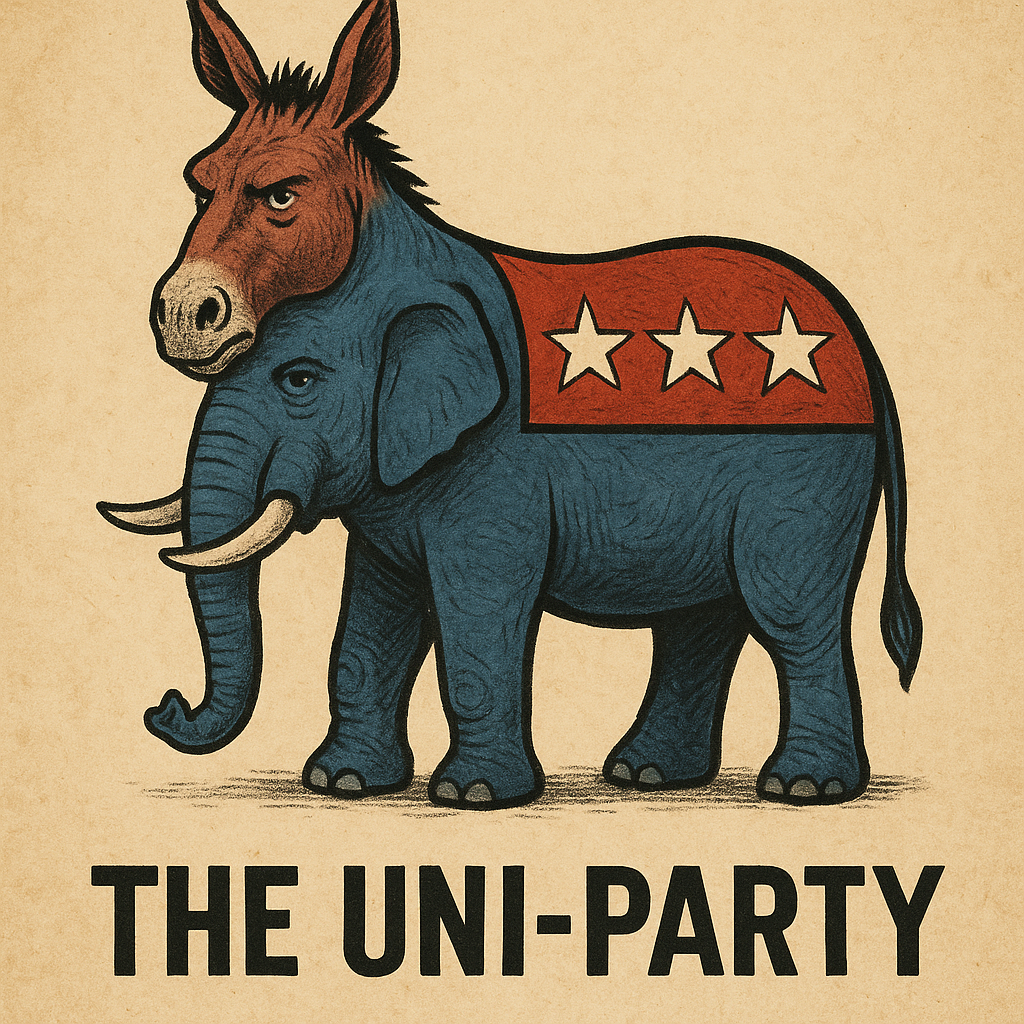Introduction
The media has sold America’s political story as a clash of red vs. blue, but the scoreboard never changes: elites win, the rest of us lose. Wall Street, the Military Industrial Complex, Big Tech, and Big Pharma walk away richer every decade, regardless of which party occupies the White House. That’s not democracy; it’s a revolving door with two paint colors.
I’ve called this before the “uni-party.” However, the more I look at it, the clearer I see that the Trump Administration is nothing like a liberating detour. Conversely, it merges power and authoritarianism dressed in Republican red—a consumerist trap that blurs the line between the public and private sectors and has all of Big Tech bowing the knee before them.
From Reagan to Biden: Different Names, Same Winners
The trend is undeniable if you trace trade and economic policies since the Reagan years.
- Reagan broke unions and slashed taxes for the rich.
- George H. W. Bush pushed NAFTA and bailed out the S&L mess, leaving taxpayers with the bill.
- Clinton finalized NAFTA, deregulated Wall Street, and expanded mass incarceration.
- Bush Jr. delivered wars without end, the Patriot Act, and surveillance on steroids.
- Obama bailed out banks, drone-bombed the Middle East, and left Wall Street untouched.
- To the CEO’s delight, Trump cut corporate taxes and deregulated them.
- Biden, despite populist branding, hardly shook up the corporate consensus.
Different parties, same outcome: a system tilted upward while working people sink. That’s the uni-party pattern.
My Biden Setup Theory
Biden’s presidency was haunted by visible decline almost from the outset. Forget partisanship — it was apparent he wasn’t entirely in control. Which begs the question: Who was? Staffers? Party elders? An overzealous subordinate? Or perhaps the same network of extreme wealth and corporate power brokers quietly steering both parties for decades?
Here’s the kicker: Biden’s decline not only left us with a bad taste in our mouths regarding the Democratic Party, but it was also the perfect setup. A shaky, stumbling presidency conditioned Americans to crave something “decisive.” No nuance or timidity, but a strongman. And right on cue, Trump is reintroduced, not as a fluke, but as the “solution.”
Why the Strongman Suits the Moment
Globally, authoritarianism is trending. From Orbán to Erdoğan, Modi to Putin, the template is clear: Prey on the fears of your less diverse supporter base by exaggerating the current crime-related data trends, and promise safety and order in a society seemingly on the verge of collapse. This will accomplish two significant goals:
- Use fear to secure votes from an already loyal voter base, in this case, older American populations who see voting red as voting for their security.
- Consistent threats of extreme crime waves and societal breakdown pacify the public into normalizing the use of military power to crush domestic opposition of any kind.
Elites don’t want a soft-spoken technocrat in a turbulent America already rife with inequality, polarization, and unrest. They want someone who can deregulate quickly, smash unions, silence critics, and promote “law and order.” A Republican authoritarian fits the script perfectly.
The Big Tech Twist
Here’s where things get truly dangerous. While Trump plays the populist strongman on stage, his administration is tightening its bond with Silicon Valley behind the curtain.
- Surveillance partnerships expand facial recognition, predictive policing, and AI-powered border control.
- Platforms are pressured to curate or bury narratives — censorship by proxy.
- Digital ID systems and biometric tech creep into everyday life, giving the state and its corporate partners new power to decide who counts.
This is the merger of two worlds: the Democratic idea of technocracy — rule by experts and algorithms — fused with Republican authoritarianism. A hybrid regime: a surveillance state run like a corporation, enforced like a dictatorship.
The Uni-Party’s Long Game
Seen in this light, Trump’s authoritarian bent may not have been unintentional, as MAGAs would have us believe. Instead, the system is simply evolving. The elites didn’t fight it because it serves them. In fact, they may have choreographed it.
The arc looks like this:
- Two parties fight on TV, but converge on elite interests behind the curtain.
- The illusion of choice pacifies and distracts voters for decades.
- A controlled collapse (Biden’s frailty, dysfunction in Washington) primes the public to beg for order.
- The strongman rises — not as an outsider, but as the system’s most efficient vessel.
- Big Tech ascends to power, transforming authoritarianism into a digitally enforced order.
Call It What It Is
We’re told we’re “sliding toward dictatorship.” That’s too generous. The truth may be harsher: authoritarianism isn’t a slide; it’s the next phase of the uni-party.
They didn’t need a coup. They didn’t even need tanks in the streets. They just tightened the screws, kept wealth funneling up, and let us argue red vs. blue while the real merger was solidified behind closed curtains.
Meaning Trump wasn’t some unaccounted-for, renegade candidate who managed to slip through elite clutches and is here to benefit us commoners (or so he and his base would have you believe). Instead, he may be the next step in a carefully constructed ploy by the elite class to truly take that last authoritarian/technocratic hammer stroke that we’ll likely regret terribly when enacted in policy.
Stay authentic friends. -MiStyk










Leave a Reply to Paul Carney Cancel reply